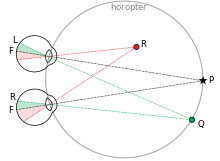
In biology, binocular vision is a type of vision in which an animal has two eyes capable of facing the same direction to perceive a single three-dimensional image of its surroundings. Binocular vision does not typically refer to vision where an animal has eyes on opposite sides of its head and shares no field of view between them, like in some animals.[which?]
Neurological researcher Manfred Fahle has stated six specific advantages of having two eyes rather than just one:[1]
- It gives a creature a "spare eye" in case one is damaged.
- It gives a wider field of view. For example, humans have a maximum horizontal field of view of approximately 190 degrees with two eyes, approximately 120 degrees of which makes up the binocular field of view (seen by both eyes) flanked by two uniocular fields (seen by only one eye) of approximately 40 degrees.[2]
- It can give stereopsis in which binocular disparity (or parallax) provided by the two eyes' different positions on the head gives precise depth perception. This also allows a creature to break the camouflage of another creature.
- It allows the angles of the eyes' lines of sight, relative to each other (vergence), and those lines relative to a particular object (gaze angle)[3] to be determined from the images in the two eyes.[4] These properties are necessary for the third advantage.
- It allows a creature to see more of, or all of, an object behind an obstacle. This advantage was pointed out by Leonardo da Vinci, who noted that a vertical column closer to the eyes than an object at which a creature is looking might block some of the object from the left eye but that part of the object might be visible to the right eye.
- It gives binocular summation in which the ability to detect faint objects is enhanced.[5]
Other phenomena of binocular vision include utrocular discrimination (the ability to tell which of two eyes has been stimulated by light),[6] eye dominance (the habit of using one eye when aiming something, even if both eyes are open),[7] allelotropia (the averaging of the visual direction of objects viewed by each eye when both eyes are open),[8] binocular fusion or singleness of vision (seeing one object with both eyes despite each eye having its own image of the object),[9] and binocular rivalry (seeing one eye's image alternating randomly with the other when each eye views images that are so different they cannot be fused).[10]
Binocular vision helps with performance skills such as catching, grasping, and locomotion.[11] It also allows humans to walk over and around obstacles at greater speed and with more assurance.[12] Optometrists and orthoptists are eyecare professionals who fix binocular vision problems.
- ^ Fahle, M (1987). "Wozu zwei Augen? [Why two eyes?]". Naturwissenschaften. 74 (8): 383–385. Bibcode:1987NW.....74..383F. doi:10.1007/BF00405466. PMID 3657989. S2CID 32015271.
- ^ Henson, D.B. (1993). Visual Fields. Oxford: Oxford University Press.
- ^ Qayyum. "Gaze Angle". Huntgearpro.com. Asad Qayyum.
- ^ Longuet-Higgins, H. C. (1982). "The role of the vertical dimension in stereoscopic vision". Perception. 11 (4): 377–386. doi:10.1068/p110377. PMID 7182797. S2CID 24721194.
- ^ Blake, Randolph; Fox, Robert (August 1973). "The psychophysical inquiry into binocular summation". Perception & Psychophysics. 14 (1): 161–85. doi:10.3758/BF03198631.
- ^ Blake, R.; Cormack, R. H. (1979). "On utrocular discrimination". Perception & Psychophysics. 26: 53–68. doi:10.3758/BF03199861.
- ^ Miles, W. R. (1930). "Ocular dominance in human adults". Journal of General Psychology. 3 (3): 412–430. doi:10.1080/00221309.1930.9918218.
- ^ Hariharan-Vilupuru, S.; Bedell, H. E. (2009). "The perceived visual direction of monocular objects in random-dot stereograms is influenced by perceived depth and allelotropia". Vision Research. 49 (2): 190–201. doi:10.1016/j.visres.2008.10.009. PMID 18992271.
- ^ Panum, P. L. (1858). Über die einheitliche Verschmelzung verschiedenartiger Netzhauteindrucke beim Sehen mit zwei Augen. Kiel.
- ^ Wheatstone, C (1838). "Contributions to the physiology of vision.—Part the First. On some remarkable, and hitherto unobserved, phænomena of binocular vision". Philosophical Transactions of the Royal Society of London. 128: 371–394. Bibcode:1838RSPT..128..371W. doi:10.1098/rstl.1838.0019. S2CID 36512205.
- ^ Heinen, T., & Vinken, P. M. (2011). Monocular and binocular vision in the performance of a complex skill. Journal of Sports Science & Medicine 10(3), 520-527. Retrieved from: http://www.jssm.org/
- ^ Hayhoe M, Gillam B, Chajka K, Vecellio E (2009). "The role of binocular vision in walking". Visual Neuroscience. 26 (1): 73–80. doi:10.1017/S0952523808080838. PMC 2857785. PMID 19152718.